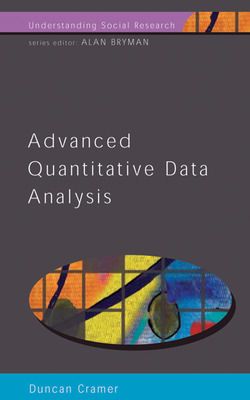ADVANCED QUANTITATIVE DATA ANALYSIS
1st Edition
0335200591
·
9780335200597
© 2003 | Published: July 16, 2003
*What do advanced statistical techniques do?*When is it appropriate to use them?*How are they carried out and reported?There are a variety of statistical techniques used to analyse quantitative data that masters students, advanced undergraduates and …
Read More
Request Review Copy
Request More Info
Receive via shipping:
- Colour, print bound version of the complete text
Series editor’s foreword
Preface
1 Introduction
PART 1
Grouping quantitative variables together
2 Exploratory factor analysis
3 Confirmatory factor analysis
4 Cluster analysis
PART 2
Explaining the variance of a quantitative variable
5 Stepwise multiple regression
6 Hierarchical multiple regression
PART 3
Sequencing the relationships between three or more quantitative variables
7 Path analysis assuming no measurement error
8 Path analysis accounting for measurement error
PART 4
Explaining the probability of a dichotomous variable
9 Binary logistic regression
PART 5
Testing differences between group means
10 An introduction to analysis of variance and covariance
11 Unrelated one-way analysis of covariance
12 Unrelated two-way analysis of variance
PART 6
Discriminating between groups
13 Discriminant analysis
PART 7
Analysing frequency tables with three or more qualitative variables
14 Log-linear analysis
Glossary
References
Index
Preface
1 Introduction
PART 1
Grouping quantitative variables together
2 Exploratory factor analysis
3 Confirmatory factor analysis
4 Cluster analysis
PART 2
Explaining the variance of a quantitative variable
5 Stepwise multiple regression
6 Hierarchical multiple regression
PART 3
Sequencing the relationships between three or more quantitative variables
7 Path analysis assuming no measurement error
8 Path analysis accounting for measurement error
PART 4
Explaining the probability of a dichotomous variable
9 Binary logistic regression
PART 5
Testing differences between group means
10 An introduction to analysis of variance and covariance
11 Unrelated one-way analysis of covariance
12 Unrelated two-way analysis of variance
PART 6
Discriminating between groups
13 Discriminant analysis
PART 7
Analysing frequency tables with three or more qualitative variables
14 Log-linear analysis
Glossary
References
Index
*What do advanced statistical techniques do?
*When is it appropriate to use them?
*How are they carried out and reported?
There are a variety of statistical techniques used to analyse quantitative data that masters students, advanced undergraduates and researchers in the social sciences are expected to be able to understand and undertake. This book explains these techniques, when it is appropriate to use them, how to carry them out and how to write up the results. Most books which describe these techniques do so at too advanced or technical a level to be readily understood by many students who need to use them. In contrast the following features characterise this book:
- concise and accessible introduction to calculating and interpreting advanced statistical techniques
- use of a small data set of simple numbers specifically designed to illustrate the nature and manual calculation of the most important statistics in each technique
- succinct illustration of writing up the results of these analyses
- minimum of mathematical, statistical and technical notation
- annotated bibliography and glossary of key concepts
Commonly used software is introduced, and instructions are presented for carrying out analyses and interpreting the output using the computer programs of SPSS Release 11 for Windows and a version of LISREL 8.51, which is freely available online. Designed as a textbook for postgraduate and advanced undergraduate courses across the socio-behavioural sciences, this book will also serve as a personal reference for researchers in disciplines such as sociology and psychology.
*When is it appropriate to use them?
*How are they carried out and reported?
There are a variety of statistical techniques used to analyse quantitative data that masters students, advanced undergraduates and researchers in the social sciences are expected to be able to understand and undertake. This book explains these techniques, when it is appropriate to use them, how to carry them out and how to write up the results. Most books which describe these techniques do so at too advanced or technical a level to be readily understood by many students who need to use them. In contrast the following features characterise this book:
- concise and accessible introduction to calculating and interpreting advanced statistical techniques
- use of a small data set of simple numbers specifically designed to illustrate the nature and manual calculation of the most important statistics in each technique
- succinct illustration of writing up the results of these analyses
- minimum of mathematical, statistical and technical notation
- annotated bibliography and glossary of key concepts
Commonly used software is introduced, and instructions are presented for carrying out analyses and interpreting the output using the computer programs of SPSS Release 11 for Windows and a version of LISREL 8.51, which is freely available online. Designed as a textbook for postgraduate and advanced undergraduate courses across the socio-behavioural sciences, this book will also serve as a personal reference for researchers in disciplines such as sociology and psychology.

